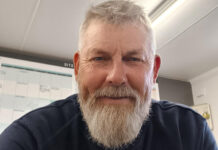
STAFF members all sit around one desk in Hoko Design – there is no hierarchy; no designated person to hop up onto the scaffolding platform turned coffee-making area; the hammock in the corner appears more for effect than purpose; but the post-mortem table that founder, Danny Campbell, wangled from his surgeon father looks to be the ideal spot for a recruitment interview to his cutting-edge architecture business.
Indeed, as the office space suggests, this isn’t your ordinary architecture company. The company has this year branched out to a studio space in the east end of Glasgow and begun a recruitment drive after Campbell’s business decision to target the trend of home renovations paid off.
“There’s a bit of a gap in the market for homeowners and what they need from architecture.” he said. “The industry in itself is so old fashioned and part of the nature of how people pass through the architecture education is part of that – in terms of studying and working. I think what we’re doing is quite bold, in terms of creating a start-up in this type of industry.”
Virtual reality headsets and a live tracking feature are part of the service Hoko Design offers. The prospect of stepping away from the more rudimental approach to architecture could understandably be daunting to clients, but Campbell insists it has been received well.
“We’ve proven the business model in the first six months – we’ve never had any funding or investment. The model itself seems to work; people are responding really well to it – so I wouldn’t necessarily say it’s a risk. A risk to us would be maybe growing too big too soon and losing the core values.”
Virtual reality is used on every project done by Hoko Design. The technology is well placed in Campbell’s family with his wife having used it to conduct studies during her PHD in Psychology Spatial Working Memory, so the feature is utilised to its full capability with scientific reasoning behind it.
“The virtual reality seems to transform people’s perception of the designs – looking at a drawing a lot of people struggle to visualise what they’re actually looking at. For us, it helps us get into all the little nooks and crannies and nit-pick the designs a lot better and really get a more thorough design process under way,” he added. “We show internal finishes, furniture, where windows will be going, where kitchen appliances are going to go – it really is a thorough display of what the design could be like.
“We’ll start them off in an existing room and then let them walk through the virtual environment into the new proposal. What they get shown is the proposal in its entirety – which is quite a lot to take in, but what we find is that it’s a lot easier to comprehend than a plan.”
With clients already being able to visit their new home area – albeit in the virtual world – the tracking system is an undoubted plus for those awaiting renovations, particularly as the system follows through into the actual build of the plans.
“There is an element of pressure (to work being tracked) but we’ve got nothing to hide, so we really try to put our heart on our sleeves with clients – so we are open to communication, and our values are transparency and clarity.
“When a project takes several months to go through its life cycle that sort of drip feed of information really puts people at ease and lets them be aware that they’re in a process and that we’re in control of it.
“When it goes to local authority – it is really important to keep the client informed of what’s going on and any risks or correspondence that’s been had.
“So I don’t see it as pressure as it’s something we do naturally. And actually, it’s a huge selling point that we can communicate so clearly without having to expend time which would obviously put the costs up.”
Campbell plans on branching out by opening an office space in Edinburgh within the next couple of months, but insists the creative vibe of the east end is somewhere he’d like to remain in Glasgow, as he pushes forward with his new wave of architecture.








